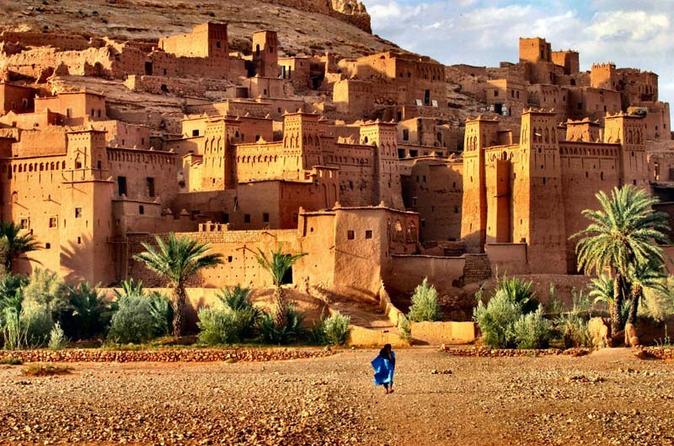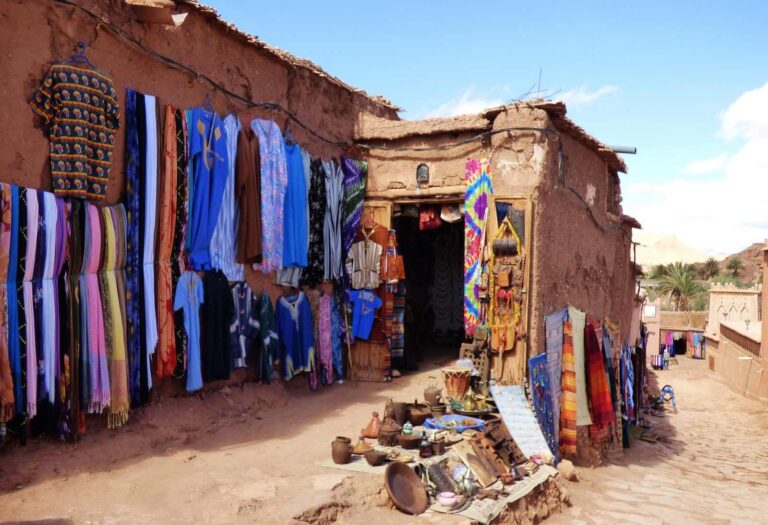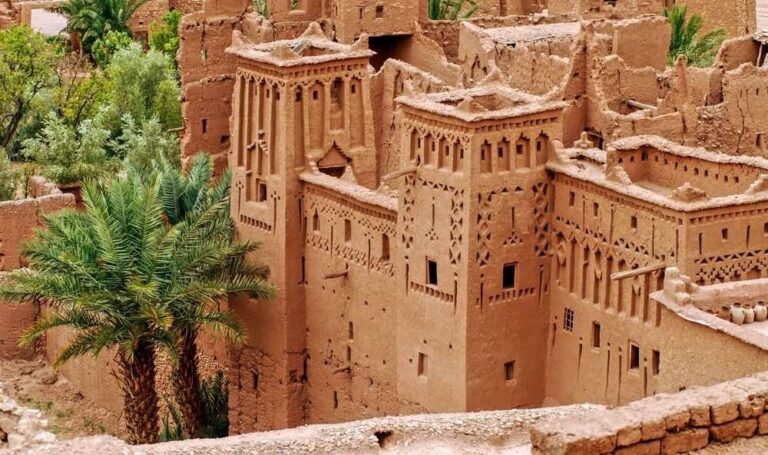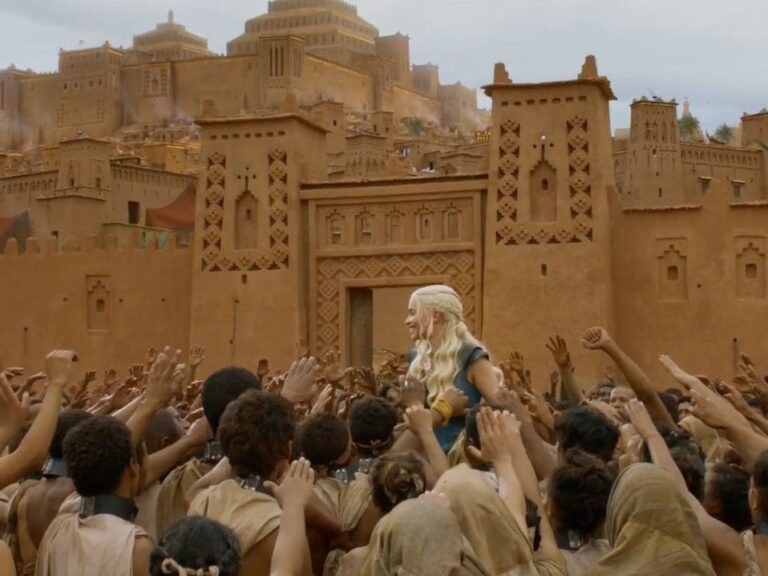Kasbah Ait Ben haddou
Kasbah Aït Ben haddou is a fortified village. A great example of Moroccan earthen clay architecture has been UNESCO World Heritage site since 1987. Ksar Ait Benhaddou is a cherished destination for nature and history lovers. Built ten centuries ago, it is surrounded by an outstanding nature of palmiers, mountains, and rivers.

LOCATION OF AIT BEN HADDOU
The ksar of Ait Ben Haddou is located in the foothills on the southern side of the High Atlas belonging to the Province of Ouarzazate, 30 kilometers away from the center of the city center. This site is the most famous ksar in the Ounila Valley standing in the middle of the arid desert, green and abundant is a treat to the eyes.
About Ait Benhaddou
The ksar is a group of earthen buildings surrounded by high walls, is a traditional pre-Saharan habitat. The houses crowd together within the defensive walls, which are reinforced by corner towers. Ait-Ben-Haddou, is a representative example of the architecture of southern Morocco.
The ksar is a mainly collective grouping of dwellings. Inside the defensive walls which are reinforced by angle towers and pierced with a baffle gate, houses crowd together – some modest, others resembling small urban castles with their high angle towers and upper sections decorated with motifs in clay brick – but there are also buildings and community areas. It is an extraordinary ensemble of buildings offering a complete panorama of pre-Saharan earthen construction techniques. Ksar Ait Benhaddou is around 1,300 square meters. Made of red clay bricks, it has many long and narrow alleys tangling up in a unique geometric shape.The oldest constructions do not appear to be earlier than the 17th century, although their structure and technique were propagated from a very early period in the valleys of southern Morocco. The site was also one of the many trading posts on the commercial route linking ancient Sudan to Marrakesh by the Dra Valley and the Tizi-n’Telouet Pass.
All the structures comprising the ksar are located within the boundaries of the property and the buffer zone protects its environment. The earthen buildings are very vulnerable due to lack of maintenance and regular repair resulting from the abandonment of the ksar by its inhabitants. The CERKAS (Centre for the conservation and rehabilitation of the architectural heritage of atlas and sub-atlas zones) monitors, with difficulty, respect for the visual integrity of the property.
In comparison to other ksour of the region, the Kasbah of Ait-Ben-Haddou has preserved its architectural authenticity with regard to configuration and materials. The architectural style is well preserved and the earthen constructions are perfectly adapted to the climatic conditions and are in harmony with the natural and social environment.The large houses in the lower part of the village, with well conserved decorative motifs, are regularly maintained. The construction materials used still remain earth and wood. The inclination to introduce cement has so far been unsuccessful, thanks to the continued monitoring of the «Comité de contrôle des infractions» (Rural Community, Town Planning Division, Urban Agency, CERKAS). Only a few lintels and reinforced concrete escaped its vigilance, but they have been hidden by earthen rendering. Particular attention is also paid to doors and windows giving on to the lanes, to ensure that the wood is not replaced by metal. Protection measures essentially relate to the different laws for the listing of historic monuments and sites, in particular the Law 22-80 concerning Moroccan heritage.
According to historians, the construction of the Ksar on a hill near a river was a strategic choice. First, it was for security reasons as the river and surrounding mountains created a natural fortress around the oasis. Entering and leaving the palace was possible only through two gates. Second, the closeness to the river was of good benefit for agriculture and economic influence.
Some historical sources point out that about 98 families lived in the Ksar until the 1940s. Nowadays, only five families live in Kasbah Ait Benhaddou. One of the families turned her house into a traditional coffee shop immersing visitors in natives’ lifestyles. In 1987, the UNESCO designated Ait Benhaddou Ksar as a world heritage

Ksar Ait Benhaddou visit. Attractions
Travelers can enter the village through the main entrance, where 10 Dirhams per person is charged as a donation towards the restoration of the Ksar of Ait-Ben-Haddou. There are also other entrances that can be used, but the locals may charge tourists more to use these entrances. Just check and make sure you do not get into unwanted situations. You can hire a guide on arrival to get some explanations about the kasbah. The price will depend on your negotation skills but should not be higher than 150 or 200Dh.
The community areas of the ksar include a mosque,koranic school, a public square, grain threshing areas outside the ramparts, a fortification and a loft at the top of the village, an caravanserai, two cemeteries (Muslim and Jewish) and the Sanctuary of the Saint Sidi Ali or Amer. the Ksar also houses the “collective arena” where the current inhabitants meet during family and religious events. The Ksar of Ait- Ben-Haddou is a perfect synthesis of earthen architecture of the pre-Saharan regions of Morocco.
You can also find a few artisanal shops selling rugs, jewelry, and other Moroccan handicrafts and a coffee where you can take a tea after the visit.
A few accommodations are available nearby Ksar Ait Benhaddou. Another option is to stay in Ouarzazate and drive to Ait Benhaddou

How do I get from Ouarzazate to Kasbah Ait Benhaddou?
Moroccan grand taxis are the best way to go from Ouarzazate to kasbah Ait Benhaddou and back. Your host in Ouarzazate can give you the best advice on the neared place to catch a grand taxi.
In Morocco, taxi passengers share the total cost of the convoy. You can have a taxi for yourself if you want privacy, or you can ask the taxi driver to share the drive with other passengers going to the same destination.
The drive from Ouarzazate to Ait Benhaddou is 30 minutes and costs a few hundred dirhams total. As the visit of the Ksar takes usually a couple of hours, the taxi driver can wait for you via a small arrangement/tip.
Ait Benhaddou in Films and Movies
The beautiful Ksar Aitbenhaddou has been the décor for many famous films and tv series. Several films have been shot in Aït Benhaddou, including:
- Sodom And Gomorrah(1963)
- Oedipus Rex(1967)
- The Man Who Would Be King (1975)
- The Message(1976)
- Jesus of Nazareth(1977)
- Time Bandits(1981)
- Marco Polo(1982)
- The Jewel of the Nile(1985)
- The Living Daylights(1987)
- The Last Temptation of Christ(1988)
- The Sheltering Sky(1990)
- Kundun(1997)
- The Mummy(1999)
- Gladiator(2000)
- Alexander(2004)
- Kingdom of Heaven(2005)
- Babel(2006)
- One Night with the King(2006)
- Prince of Persia(2010)
- Hanna(2011)
- Son of God (2014)
- Queen of the Desert (2015)
Also used in parts of the TV series Game of Thrones and the Brazilian TV series O Clone


